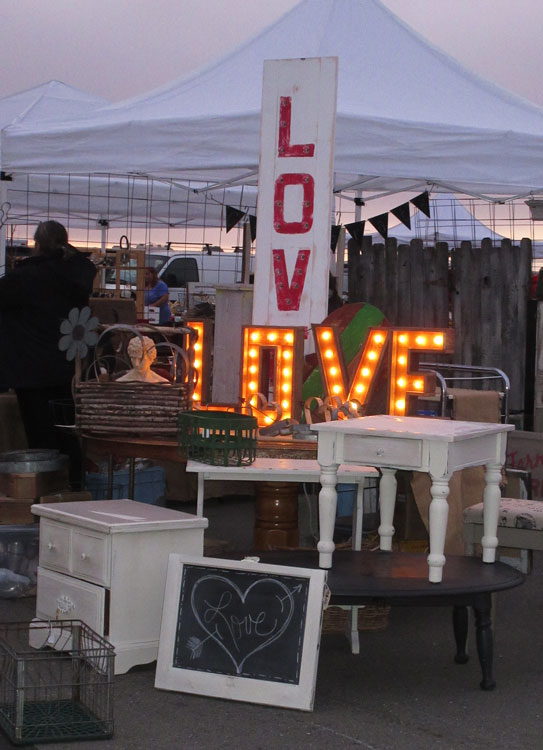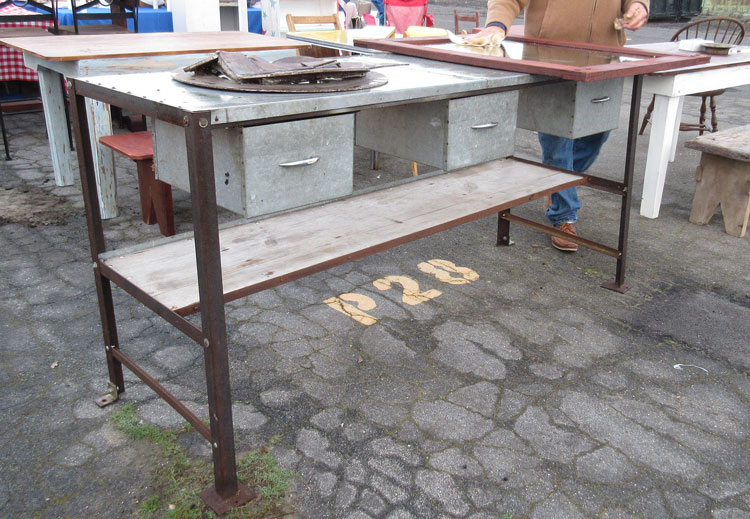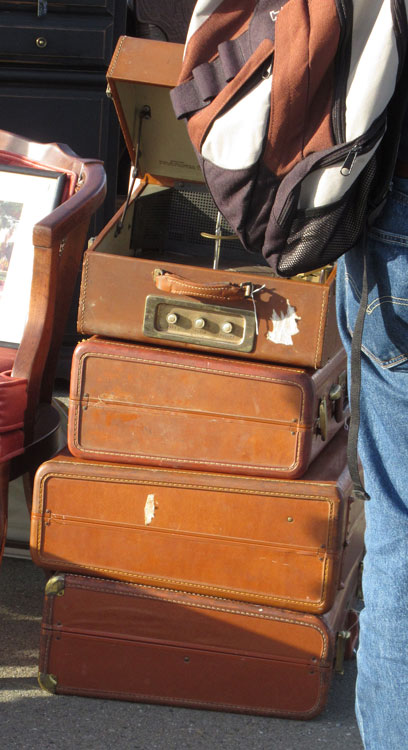West Coast Flea Scenes
On a recent trip to visit family in Los Angeles and San Francisco, we spent a couple of mornings at well-known flea markets in each of the cities. We were curious about the buying and selling scene at west coast flea markets, and were also hoping to find some things for inventory.
Before dawn on the morning after we landed at LAX, we made our way to the Santa Monica Airport Antiques and Collectibles Market. It was not yet light when it opened to early buyers at 6 am, but there we were, trained from years of attending the Brimfield, Mass markets to arrive while dealers were unpacking to get the first look at their wares.
Jeff took off ahead of me to start roving the field, while being cautious not to make purchases in the dark - even a flashlight is no substitute for daylight when examining an antique's condition and authenticity (does that sound like we've learned this the hard way?!)
A few dealers already had their booths set up, and had even brought good camp lanterns to illuminate their wares. This booth had a sign that we sort of liked (not pictured), but ultimately passed on (and now neither of us can even remember what it said, so that tells you something).
Other booths had no lights at all. We were momentarily attracted to these painted surveyors' poles in the dark, but decided they were nothing special after all.
Before we arrived, Jeff had said "I bet I'll see at least one dealer I know." As he was walking around in the murky gray light shortly after we arrived, he heard a voice behind him saying, "Hey, what are you doing here?" So here is a blurry photo taken in low light of two high-speed walkers - Jeff and a California fine arts dealer whom he knows from Brimfield shows.
That dealer, who sets up at the flea market every month, described it as "A lot of shabby chic, but you can sometimes find things." The operative definition of "things" in this context of dealer-speak, is real antiques with intrinsic value.
I wish I could follow that sentence with an illustration of real "things," but shabby chic, as in the booth pictured above, did indeed rule the day.
When the day dawned, Jeff began focusing in earnest, revisiting booths again and again until everything was unpacked. The palm trees helped me realize I was not in Maine and not at Brimfield, but in fact was on vacation, sort of.
Other popular categories were vintage clothing and industrial lighting, not so different from trendy vintage goods back east.
This tailored wool jacket from the 1920s tempted me, but it is hard to shop for oneself during business hours (wait, did I say I was there on business? jet lag confusion, I guess).
We kept our eyes sharpened for anything related to our rustic specialty, but the pickings in that regard were indeed slim.
This coppery surfaced leaping stag caught my eye, but close-up I could see that it was new and cheesy. However, I did take a shine to the (newish) gilt-painted wooden tiered serving stand which I might have purchased to use at home, if I was indeed anywhere close to home.
These owl andirons qualified as a rustic accessory, but in addition to being heavy they were in bad condition - definitely not worth buying.
This diamond willow lamp was okay, but not quite the quality or age we're after. Note the blurred form of a dealer rushing by in the background - Jeff wasn't the only one there making tracks.
This four-piece set was the closest thing to rustic furniture that we saw. Our interest in it was mostly academic - it looks like mid 20th-century southwestern or perhaps Mexican style, which we could envision fitting more into rustic adobe decor than into an Adirondack camp.
We also passed on all sorts of other treasures, such as the Mona Lisa (note the Pillsbury Doughboy doll head peeking out of the box above her - a juxtaposition that I found amusing in the wee hours of the morning).
There was some tribal material there, but no Native American art that we could find. After we had circled around and around and around the field, I was beginning to find people and their pets more interesting than the merchandise - a sure sign that it was time to leave.
So just before the gates opened for regular admission at 9 am, we were among those who had paid the early-bird entrance fee who were now pouring back out, some carrying treasures and some, like us, walking away empty handed.
My concluding thoughts were that except for the gorgeously warm, snow-free winter day that was emerging, this place was not so different from flea markets in the east. The dealers were seasoned and savvy, and good at merchandising for a retail flea market audience (largely keeping things "cheap and cheerful"). As we walked along the chain-link fence toward our car I heard one dealer remarking to another "I'm outta there (a group shop) at the end of the month. Why pay $500 for what amounts to storage space since I make no sales? I can rent a storage unit for 100 bucks and be better off." Yup, dealer concerns are much the same the world over. Her ongoing griping was blissfully fading into the distance as we walked off into stunning sunlight and the promise of bird watching on the beach that very afternoon.
About a week later when we were in northern California, we also got up at an insanely early hour to attend early buying at the Alameda Point Antiques Faire. This was a much, much bigger market.
Once again, we got there about an hour before daylight, just as most dealers were setting up.
I wondered if these dealers were looking forward to unloading their truck full of heavy, rusty metal.
Some dealers got their act together quickly, and were off doing some early shopping themselves. This booth was a portent that much of the retail audience attending later in the day would be after a decorative look.
This stack of crates unloaded from a dealer's van did not bode well for us finding our kind of antiques.
But, soft, what deer on yonder truck roof stands? It is facing east, and we are waiting for the sun(light). (Sorry, Shakespeare.)
In full light the deer still looked appealing, especially when joined by an owl and a hawk. The theme was right for us, but not the era (alas, contemporary).
And here, the price was right, but not the quality. But hey, we were there mostly for fun, so what was not to love?
How could we resist this space-age fifties hanging light? Somehow we did (seriously, it was pretty cool).
Some of the booths aimed squarely at decorators and designers had lovely French linens and stacks of other appealing textiles.
Although we did not run into any dealers we knew from the east, we did see one of the dealers who had been set up in Santa Monica. His booth (above) was mobbed early and often.
Speaking of mobs, one dealer selling jewelry, silver and other relatively expensive smalls was visibly stressed by the number of sharks closing in on his table and asking to see things from his case. He called nervously to his helper to keep his eyes open, and then said in an anxious voice to nobody in particular, "I hate it when this happens." We surmised that he had been the victim of thefts one or more times when he had lost track of who he had handed what to during other early morning rushes (or "feeding frenzies" as they are called at Brimfield).
Back in the more relaxed booths with decidedly casual presentations, vintage clothing was abundant, including fashion with a western flair.
Price points, as always, were a consideration for shoppers. I watched a young woman measuring and studying the carpet pictured below, but ultimately walking away saying, "It is just more than I want to spend," even as the dealer practically chased after her giving his finest sales pitch.
On a more positive note, I watched another dealer in fine salesmanship form pitching this wagon wheel after a 30-something woman exclaimed to her two friends, "Look, wouldn't that be great hanging in the ranch?!" Her friends oohed and aahed and coaxed her to make the purchase. There is nothing like seeing a supportive group of female friends walking through a show together; we love that energy.
These refurbished and reupholstered French Deco-era leather club chairs looked too new for my taste, but they were another category of goods that was getting a lot of attention from retail buyers. Which brings up a topic I kept overturning in my mind - namely the cycle from select decorative, but authentic antiques being exhibited at antiques shows, to knock-offs of those stylish antiques being mass produced overseas and then marketed and sold in great quantitites by retailers like Ballard Designs, to those knock-offs, or at least their "look" as promoted by online retailers to people who may have never seen the original antique prototypes, reappearing at flea markets where people flock to purchase them. Hmm - that is the topic for another article.
The booth shown below also had an attentive audience - it was filled with vintage, mostly European, educational posters.
Such posters have been trending upwards for a while, and still seem to be hot, whether old or reproduced.
Although new merchandise is technically not allowed in the market, artists who sell their own creations can rent booths, which explains the presence of this newly made, industrial metal table. We saw a few other examples of industrial-style furniture (mostly made-up rather than original pieces), but have the impression that the fad is waning.
The popularity of industrial lighting, however, has not diminished. I snapped pictures of this teenager whose father had left him holding one of five industrial light shades he had purchased, while he went to pick up a cart.
The boy carried it patiently at first, then couldn't resist having some fun with it.
While people-watching provided amusement, we again found very little that could be considered a rustic antique. This 50's advertising poster attracted my attention, but what I liked even better was its older acorn and oak leaf frame. But was it worth shipping back to Maine? We decided that it was not.
I also liked this faux bois umbrella holder at first glance, but its age was questionable and the more I looked at it, the more it began to slide down toward the unattractive end on my aesthetic judgement scale.
Since Jeff was doing laps around the field ahead of me, I didn't get photos of the few things that initially caught his eye as possible purchases - an Iroquois corn husk mask that he found on closer examination was disintegrating, and an early Native American birch bark container which also had condition issues.
There were a few things at the flea market that we could expect to see at a New England antiques show, such as this Massachusetts dry goods store display case,
and the earlier of these glass flasks.
There was another traditional antique on the grounds that we might have actually purchased - a beautiful mid-19th century tufted woolwork floral wreath in a period frame. But we were just behind a woman who had picked it up and was hammering on the dealer to come down another $5 on the price. It was a $300 item marked only $25! When she saw us lurking behind her with our eyes full of sympathy for the dealer and brimming with hunger for a real antique, she peevishly pulled out her wallet to pay the full price, then tucked the piece away in her metal shopping cart (thus no photo taken). Oh the woes of competitive shopping!
As the morning wore on and the market opened for regular admission, the lines at the gate were unbelievably long and the aisles inside became increasingly crowded.
We are used to seeing shoppers of mostly middle age and up at antiques shows, so it was remarkable to see so many people in their 20s, 30s and 40s attending this "antiques faire," including many stylish hipsters.
But not everyone was young and dressed in shades of gray - the elderly couple below was among the more colorfully dressed flea market patrons.
So with all of these people shopping, what was actually selling? I watched a dealer put a "Sold" slip on this folding copper screen, and then watched a stream of passers-by checking it out to see what they had missed.
I caught this photo of a cart filling up with purchases, which confirmed that yes, shabby chic does sell in California.
Another huge seller was vintage leather luggage.
In fact, later in the day, it was one of the most frequent things we saw leaving the field.
Some purchases were inexplicable, such as the one this man was describing to his friend as a "creepy headless child."
Lo and behold! Someone was walking out with a rustic accessory, or maybe he just hoped to use them some year in the future when the Sierras get a good snowfall again. These snowshoes were too new and mass-produced to interest us, but still it was nice to see that someone appreciated them.
Probably the things I most hated to leave behind were these two cherries signs that would be perfect for our home collection (but again, not worth shipping across country). Less than an hour later, I saw them being wheeled out of the gate by some other lucky buyer. Dang!
So needless to say, we did not need this nearby container ship to send our (zero) purchases back to Maine.
Once we said goodbye to the two family members who had good-naturedly traipsed around with us all morning, and then visited with a crew of younger-generation family with children over delicious food-truck lunches, we were ready to dispense with the flea market crowds and hit the road.
After spending forty minutes in traffic to travel about two miles back to the freeway (do people actually do this kind of thing on a daily basis???), we looked forward to a late afternoon adventure in the wild. This is a shot of the road through ranch land to Pinnacles National Park where we were lucky to see six California Condors soaring in the late afternoon light on our way back south.
And this was our final look back at the Pinnacles as the sun was setting on the day, on our vacation, and on our fruitless but fun forays into west coast flea markets.










































































